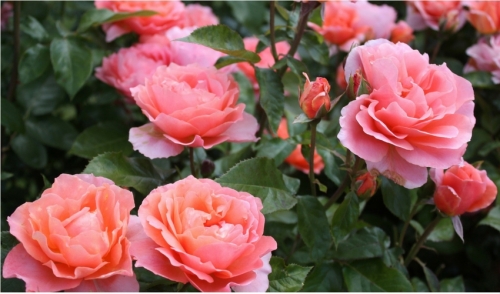
Don't Promise a Rose Garden, Deliver It
Here's a romantic gift for your special someone that keeps on giving and shows supreme effort on your part. Plant these versatile and carefree beauties now and enjoy them year after year. Choose from many varieties, each is uniquely spectacular; you can consider starting with surefire varieties such as the Carefree Wonder or Double Delight.
1. Select a Site Roses need their own space without competition from trees, shrubs or other permanent plants. Choose a well-drained location (either level or sloping) that gets 6 to 8 hours of sun daily. A southern exposure that receives morning sun and afternoon shade is ideal. The site should also have good air circulation and provide some winter protection. Allow enough room between plants, spacing as follows:
Hybrid Teas--3-5 feet. Grandifloras--2-4 feet. Floribundas--2-3 feet. Shrub Roses--4-8 feet. Patio Trees--2-3 feet. Miniatures--6-12 inches.
LANDSCAPE TIP
When planting in groups or large masses, use an odd number of plants such as 3, 5 or 7. If planting in rows, stagger bushes to give a softer effect.
2. Prepare the Soil Consult your local Home and Garden Showplace expert. Roses prefer a pH range of 5.5 to 7.0. To prepare the site for planting, remove soil from an area 18 to 24 inches wide and 24 inches deep. Add organic matter to the soil you've removed. Depending on soil type, you may or may not need to add lime.
3. Plant Roses are available as container-grown or bareroot plants. Although most are properly pruned and ready for planting, you may need to prune their tops, leaving 8 to 12 inches. Also, remove any dead or damaged wood. (If necessary, clip root tips back about 1/2 to 1 inch to promote rapid growth.) After planting, build a protective mound of earth or mulch around stems to prevent damage from cold and wind.
4. Fertilize After planting, water fertilizer in well with a root stimulator. Make another application in two weeks. This will increase root hairs and reduce transplant shock. Once growth begins, remove the protective mound around plants and feed them monthly with either an organic fertilizer, such as composted manure or a general-purpose rose food.
5. Mulch After the first feeding, apply a 3 to 6-inch layer of mulch. This will help retain moisture, moderate soil temperature, prevent weeds and add organic matter to the soil. As winter approaches, add more mulch, mounding some around the base of the plant to protect the bud union.
6. Water Newly planted roses must be watered frequently during their first 3 to 4 weeks, whenever the soil is dry in the top 2 inches. Once established, soak the planting area every 7 to 10 days during dry spells. Keep water off the leaves by using a bubbler or soaker system, and always water in the morning. Watering at night creates moist conditions that promote the spread of disease.

